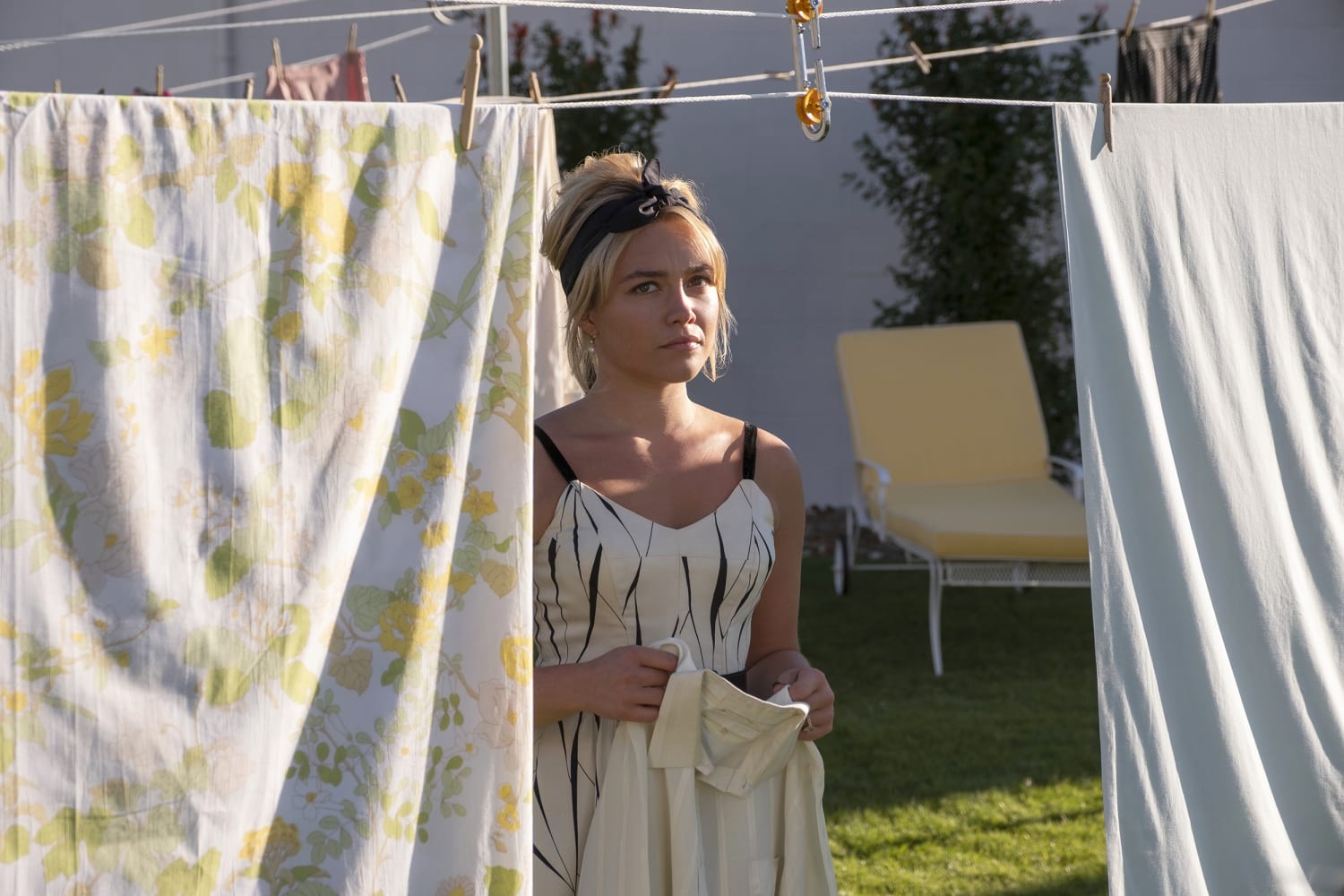Olivia Wilde’s “Don’t Worry, Darling” is — on its immaculately, obsessively polished surface — a film about the danger of dreams. But the movie is also a kind of mirror image of itself. If you look closely, it inverts, leaning into its own imagination and returning only reluctantly, and late, to the bland demands of commercial reality.
Even if you have somehow avoided all publicity for the film, the pop culture reference points should already be clear.
The film opens, with little effort to orient you, in the small desert company town of Victory, California, in a Hollywoodized 1950s. Alice Chambers (Florence Pugh) is a devoted housewife; her husband, Jack (Harry Styles), works at the “Victory Project,” along with all the other men in the neighborhood under the direction of the ominously smirking Frank (Chris Pine). The Chambers’ life seems idyllic; they have all the material luxuries they could want, lots of friendly neighbors and a passionate romance. But Alice begins to have strange visions and flashbacks. And when she starts to ask questions about what the Victory Project actually is, her comforting, perfect world starts to come apart.
Even if you have somehow avoided all publicity for the film, the pop culture reference points should already be clear. Screenwriter Katie Silberman is riffing on “The Stepford Wives” and a cornucopia of Philip K. Dick adaptations and rip-offs, from “Total Recall” to “The Truman Show” to “WandaVision.” Victory, the town, is a reactionary fantasy of female domesticity and male careerism. Frank constantly tells his underlings that their work will “change the world,” and the women are exhorted to support their husbands unquestioningly in pursuit of this nebulous but admirable goal. Alice slowly realizes that her happiness and her relationship are traps as the town starts to grow odd tumors of unreality. The third act is a rush of escape; Alice finally shakes off fantasy to seize hold of empowerment and her true self.
That’s a fairly familiar narrative, and critics haven’t been especially impressed. The movie has a 36% rating on Rotten Tomatoes at the time of publishing. But the movie is only tangentially interested in its clichéd narrative. The breakthrough to reality and self-actualization are perfunctory and stuffed into the last half-hour of the movie more as obligation than consummation. This is a Hollywood film with big-name actors; it’s got to have a plot and a resolution. It can’t be “Eraserhead.”
But it sure feels like Wilde would rather make “Eraserhead”— if you could drape “Eraserhead” in fabulous gowns and spotless retro décor. A suspense thriller is supposed to build suspense through careful ratcheting up of detail and revelations. But rather delightfully, that’s not how “Don’t Worry, Darling” works. Instead, things feel off almost immediately, and the narrative cycles round and round the wrongness without ever quite going anywhere, like the film’s dream sequences of cabaret dancers arranged in a circle kicking their legs up before dissolving into the image of a dilating eye.
Rather than a Hollywood race-through plot, this feels more like an elegantly claustrophobic art movie, suspended in its own obsessions.
The wrongness is queasy and frightening; Alice sees visions of violence and gets lost in her own head as Jack suggests she’s insane. As in a nightmare, she keeps finding herself drawn back to the same paranoid scenarios. She’s at a party where everyone is having a great time, but she becomes more and more distressed. She begs Jack to leave, but he brushes her off or won’t listen to her. Rather than a Hollywood race-through plot, this feels more like an elegantly claustrophobic art movie, suspended in its own obsessions — or like one of Douglas Sirk’s woman’s pictures, sinking into a frilled and enveloping domesticity.
This rather obvious aura of dread makes the film feel like a horror movie, rather than a thriller. But as with many horror movies, the eerie oddness is not just a fright; it’s an aesthetic pleasure. Wilde’s shots are strikingly framed. The ’50s soundtrack is curated with loving care. The clothes and the Sirkian saturated colors practically drip with sensuality. The already infamous sex scenes are centered almost entirely on female pleasure. In one, Alice lies back on a table laden with food, knocking one item after the other to the floor till the table is clean and symmetrical beneath her ruffled dress. Erotic fulfillment and aesthetic clarity are one and the same.
There’s been a lot of gossip about tension between Wilde and Florence Pugh on set. If there was any, it doesn’t seem to have affected the performance, though. Pugh conveys blissful serenity and anguished confusion with equal conviction; her deftness justifies Wilde’s poetic anti-narrative, and vice versa. Harry Styles (as an actor, at least) is a pretty nonentity. Pugh outclasses him so entirely and so effectively that it’s difficult to even look at him when they’re on screen together. But that is definitely the point. The love affair between Jack and Alice fades toward irrelevance as director and lead twirl and float together through a sunny suburb built like a skull.
The movie’s strength is in exploring that skull, not in escaping it. It’s a film that I think will bear repeated viewings, but even on my first time through, there are a wealth of wonderful details. I think my favorite is a scene in which Alice is in the bathtub after a mental health crisis, and Jack tells her he wants to think about having children. She is stunned virtually into paralysis. When he leaves, she looks in the mirror, then submerges. But her reflection lingers for a split second after she’s beneath the water, a version of herself she can’t leave behind — or which won’t let her go.
Compared to this virtuoso play with image and self and meaning, the scenes that tell us what is “really” going on are mundane and drab, lacking the glamour and subtlety that make the bulk of the film so much fun to watch. It’s the fake world that most intensely embraces the film’s potential. The real world feels like ghostly and desaturated reflection.
You could argue that Wilde is showing the seductiveness of the upper-middle-class ’50s milieu, with every gender in its place and a house stuffed with deviled eggs and other toothsome material things. But the director also just seems to be in love with creativity, building up textures and characters and dreams for their own sake. “Don’t Worry, Darling” is a movie that airily warns you to watch out for illusions even as it revels in a film’s power to create a world deliberately untethered from reality. A film that feints toward an explanation of women’s reality in order to embrace women’s imagination may be too idiosyncratic for critical or commercial success in the short term. But I think it will find its audience eventually.
Source: | This article originally belongs to Nbcnews.com











